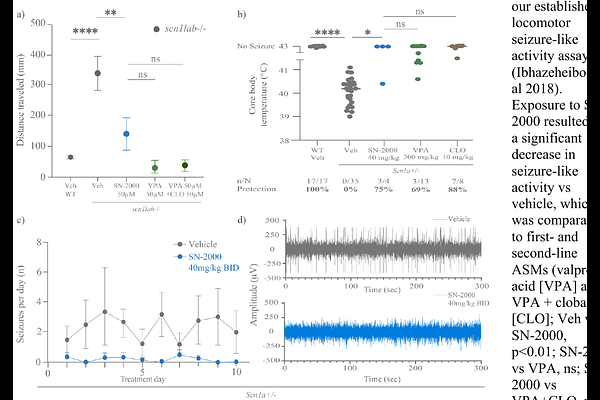Inhibition of phosphodiesterase 4B as a novel therapeutic strategy for the treatment of refractory epilepsy

Inhibition of phosphodiesterase 4B as a novel therapeutic strategy for the treatment of refractory epilepsy
Kinch, C. D.; Kesler, M.; Dogra, D. D.; Morin, K.; Ibhazehiebo, K.; Noschang, C. G.; Rho, J. M.; Kurrasch, D.
AbstractDespite the availability of nearly 40 approved anti-seizure medications (ASMs), at least one-third of individuals with epilepsy remain refractory to treatment, and many experience life-limiting cognitive or psychiatric side effects. Using a machine learning-guided platform, we identified PDE4 as an underexplored anti-seizure target, which became further validated based on its enriched expression in seizure-relevant brain regions and its potential to modulate excitatory/inhibitory neuronal tone via cAMP signaling. The pan-PDE4 inhibitor crisaborole partially protected against hyperthermia-induced seizures and reduced spontaneous seizures in Scn1a+/- mice, while rolipram and roflumilast showed no efficacy at tolerable doses. SN-2000, a first-in-kind allosteric modulator of PDE4B, was rationally designed for isoform selectivity and brain penetration, and demonstrated versatile reduction of seizure activity across multiple zebrafish and rodent genetic and acquired epilepsy models, with efficacy comparable to standard-of-care ASMs. SN-2000 also demonstrated favorable behavioral outcomes, reducing post-ictal aggression and anxiety-like behaviors, and improving cognitive performance in both wild-type and epileptic mice. These effects were linked to paradoxical regulation of excitatory and neuronal activity in the cortex and thalamus of epileptic mice, respectively, as well as elevated cAMP signaling and downstream pCREB activation. Together, these findings support PDE4B inhibition as a disease-relevant mechanism in epilepsy, and position SN-2000 as a promising therapeutic candidate offering seizure control without the neuropsychiatric burden of existing ASMs and potential pro-cognitive properties.